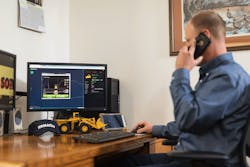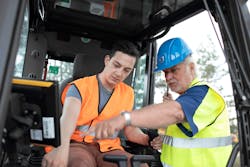Telematics has given equipment managers in-depth understanding into machine performance and operation. Managers have also come to understand that the data transmitted from a machine can reveal accurate accounting of how an operator performs, including insight into not only simple behavior such as idling, but also more subtle actions such as braking habits and how often they use machine automation or power modes.
All of these behaviors impact operating costs and, ultimately, the profitability of the project and the organization. Yet changing operator behavior remains a difficult and, frankly, uncomfortable task for people responsible for the machine’s performance. Rather than grading or criticizing operators with data, managers can use it in a coaching process that protects the organization’s investment in its working assets and also boosts operator morale, expertise, and performance.
Coaching differs from training in that it’s a conversation rather than an instruction process. A two-way framework of communication benefits the fleet and the operator or driver, who will see coaching as a positive experience designed to help them improve.
Del Lisk, VP safety services for Lytx, a video services supplier, defines coaching as sitting with a person, listening, understanding, collecting information, bouncing ideas off the person, and guiding them to come to the decisions about what they need to do differently.
More on how machine data can improve operator performance
An organization that rewards improvement—which should lead to reduced costs and improved profits—solidifies the positive nature of the experience. A cookout to celebrate a reduction in certain performance metrics, the number of fault codes, for example, reinforces the fact that the entire organization gains from excellence.
An equipment-using organization must have a foundation in place before creating a coaching program that uses data, say experts. Tim Noon, global quarry technology SME for construction digital and technology for Caterpillar, suggests four key principles for a program: It gives the operator a manageable number of areas to address, it uses facts and data to engage the operator in a positive manner, it provides coaching based on these manageable areas and the facts and data, and it is built into the monitoring process in order to continue the success.
With that strategy in place, Noon says, managers can identify one or two fault codes and coach. If a fault code indicates that an emissions regeneration has been terminated by the operator, for example, “explain to the operator the importance of that.”
“‘I know I’m trying to get you to produce, but this is necessary for the health of the machine and the longevity and the cost of the machine, and our overall company’s success.’ The operator now understands,” he says. “They’ve built a positive experience.”
Equipment managers can also use data aggregated for a particular machine type—whether across their own fleet or from a dealer’s database—to identify benchmarks that reveal who might need coaching, says James Leibold, product marketing manager, connected solutions, John Deere.
“If you have operators in 100 different loaders, you can use this to compare operators against each other, to set a baseline...[to determine] who might need some coaching,” he says.
Above: Komatsu TSEs can access operator data remotely, offering real-time support.
Travelers, an insurance provider, suggests that the foundation must also include performance criteria and accountability.
“If the company’s policy says a driver who has more than two accidents in a 24-month period will have a change in their driving responsibilities, and a driver has two accidents,” Bringgold says, “then follow through on your company policy to, for example, move them into a different position for 12 to 24 months until their record clears up.
“Once fleet managers establish the foundation, coaching based on this foundation can become more readily accepted by the drivers.”
Coaching works, and it pays off in hard dollars measured in fuel savings, reduced cost of ownership, and greater utilization. Insurance savings are another cost benefit. Travelers cites studies that show fleets can reduce the frequency of accidents by 30 to 40 percent in a year when telematics is used to coach driver behavior. Lytx’s Lisk says claims costs, the money paid for bent metal and injuries, can fall by 50 to 80 percent initially. Premium reductions would logically follow, if the improvements can be maintained.
Once the foundation is laid, fleets can turn to specific metrics. One of the simplest and most immediately beneficial is fuel burn, which can be identified by idle time and mode of operation. Aaron Kleingartner, dealer and product marketing manager, Doosan North America, says an equipment manager can look at operational data over a period of time to determine where coaching could be used. The use of high power mode and high idle times might indicate a problem, he says, but a deeper look would reveal where to focus.
“If you’re taking a look at a series of days of operation on a machine...you can dive deeper into that data and see what the loads were on the pump and the engine during that time of high power or high idle. Use that as a training tool: ‘There were certain times where the machine was not working that hard. What were you doing from 1 [to] 4 on the afternoon of Wednesday?’”
Richie Snyder of Case Construction Equipment, concurs.
“Are they running it full speed, all out, like a racetrack when they don’t need to be? Is that additional wear and tear on the undercarriage of the machine, higher engine temps, not to mention job site safety? Let’s drill into that before we create an unsafe environment.”
Fleets can take advantage of telematics reports supplied by their dealer or OEM that display quickly and easily data that can lead to coaching. Volvo’s ActiveCare Direct does that, says Dave Adams, connectivity services support manager:
“By having a report that identifies these items easily, they can quickly turn that item into a training session. They are able to quickly identify where they want to attack, what they want to improve, and make those improvements.”
Equipment managers can also monitor the use of machine control and machine automatics. These operational aids boost production and efficiency, and they can also reduce fuel burn and operating costs.
Michael Salyers, senior product manager, smart construction solutions for Komatsu, says the company’s Intelligent Machine Control opens opportunities for operator coaching.
“We are able to understand how the machine is working [ads] it is working,” he says. “[Fleet managers] can see...how often the tracks are slipping, how close they are to design, if they’re even working in designs....Now the customer can see the percentages of time each operator is using the technology....Maybe he needs more coaching.
“Automation should increase production anywhere between 30 and 70 percent,” he says. “[A]bout 50 percent of the maintenance/repair cost on a dozer is undercarriage. [I]f we can reduce track slip by using automation more, we’re going to prolong the life of that undercarriage, thus extending the life of the dozer.”
Video data supplements machine data, say suppliers, and give fleets an additional layer of coaching direction. Lytx’s Lisk uses hard braking as an example. Simply showing a driver a report listing the number of instances makes for a “challenging conversation,” he says.
“But if I instead share a video with you, where you were looking at paperwork for several seconds going down the road, and then at the very last moment looked up and swerved to avoid a bike rider, that’s a much more powerful and effective way of communicating and changing behavior.”
Video providers are also bringing artificial intelligence (AI) to bear on the coaching process, teaming their video database with machine data to identify behaviors most likely to lead to safety problems. He explains how machine vision (data recorded via cameras mounted in the cab and on the machine) and artificial intelligence work together.
“The technology is trained to recognize if the driver is holding a cellphone in their hand,” Lisk says. “It can be configured to capture that video; it can also be configured to simply send the driver an alert. If they don’t put the phone down, it will then capture video.
“[This] shifts the coaching from management...to the driver. It’s their opportunity first to self-correct that behavior. If you had 20 people you need to coach, but 17 could self-correct, that sure makes the day more efficient.”
Although AI offers much potential for self-correcting, the fact remains that the reason that fleets have not taken full advantage of coaching is because the skill set is not common among equipment managers or operations managers. Dealers and distributors, however, can fill that gap.
“In 2021, customers are probably beyond suffering from information and data overload,” says Caterpillar’s Noon. “Everything is digitally connected, and the data is coming from everywhere. Dealers are “step[ing] up: ‘Mr. customer, we’ve noticed that we see something here in your PMs and in these fault codes that could be addressed with some simple training.’”
Doosan’s Kleingartner says the dealer can be the data partner for a fleet.
“Even as great as the interface and the user experience are with today’s telematics platforms, it’s very easy to get overwhelmed with the data,” he says. “A dealer can be that subject matter expert for you with that data and help you through some of those scenarios that could in time significantly improve your cost position for a project.”
Case’s Snyder says their dealers are focusing on not only predictive maintenance services, but also operational improvements.
“If you’re bringing value to the operator, they will stop and listen to you,” he says. “Because if they can make the job easier, and they can be more productive, then they look a lot better to his bosses. The overall job and the overall company is being more productive and profitable.”
All John Deere construction equipment dealers have telematics departments, says Leibold. The dealer can work with operators to help them read the monitor and learn where their blade tip is, he says, or how to use offsets on the company’s SmartGrade controls.
“Then they can view the telematics site and look at all the operators’ data and start picking out who might need some coaching.”
Operators literally hold the keys to an equipment organization’s success, not only in production and profits, but also in equipment operating costs and asset management metrics. Organizations can use machine data to coach them to use those keys to the best of their abilities.
About the Author
Rod Sutton
Sutton has served as the editorial lead of Construction Equipment magazine and ConstructionEquipment.com since 2001.
Our mission is to help managers of heavy equipment and trucks to improve their performance in acquiring and managing their fleets. One way we do that is with our Executive Institute, where experts share information and ideas that will enable equipment managers to accurately manage equipment costs so that they can deliver the optimum financial benefits to their organizations.
We also have a laser focus on product development, performance, and technology; as well as equipment acquisition, disposal, and maintenance. Our exclusive Field Tests take earthmoving equipment and truck into the field for professional evaluations.
Check out our free newsletters to see the latest content.
You can find Sutton on LinkedIn.



